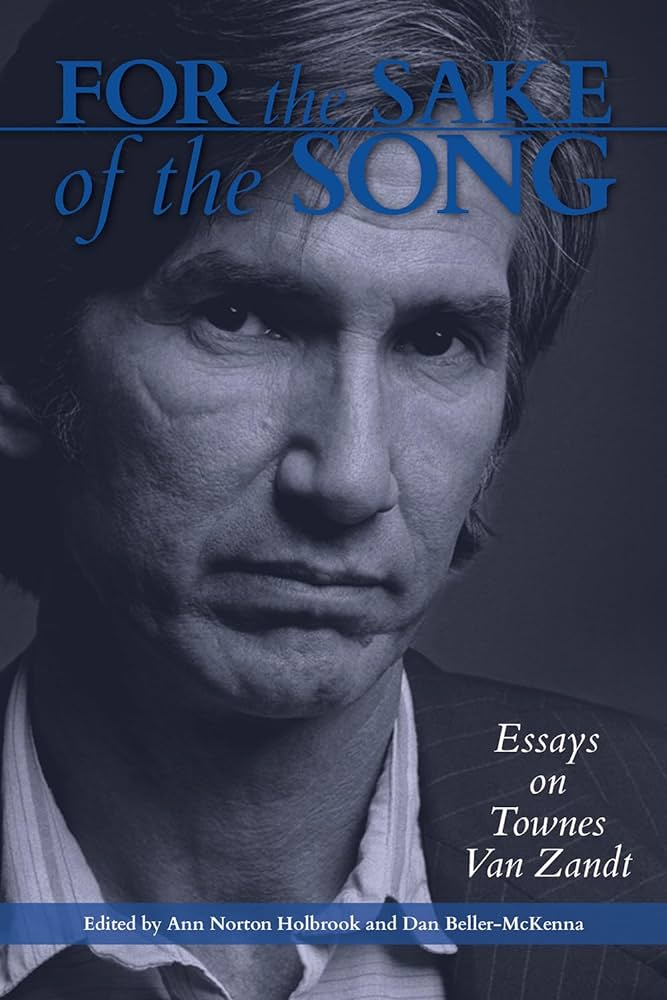JTMH Volume 23 | Reviews
For the Sake of the Song: Essays on Townes Van Zandt
Edited By Ann Norton Holbrook and Dan Beller-McKenna (Denton: University of North Texas Press, 2022)

Townes Van Zandt has been renowned as one of the greatest Texas songwriters. For the Sake of the Song: Essays on Townes Van Zandt offers a new look at the fabled songwriter through the lenses of literary criticism, musicology, cultural studies, and psychology. This edited collection traces Van Zandt’s story from his wealthy upbringing in Fort Worth, Texas, to his career as a songwriter, to the mental turmoil he suffered and the resulting drug and alcohol addictions he endured throughout his life.
The book’s introduction, written by editors Ann Norton Holbrook and Dan Beller-McKenna, admits that the collection is not an all-inclusive overview of Van Zandt’s life, as that has already been well covered in other works such as John Kruth’s To Live’s To Fly: The Ballad of the Late, Great Townes Van Zandt; Robert Hardy’s A Deeper Blue: The Life and Music of Townes Van Zandt; and Brian Atkinson’s I’ll Be Here in the Morning: The Songwriting Legacy of Townes Van Zandt. Rather, this work complements these existing stories by analyzing Van Zandt’s upbringing, songwriting, musicianship, relationships, and mental health in new, unique ways.
The book’s early chapters are written by two Van Zandt experts, Brian Atkinson and Robert Hardy, both of whom have previously published works on the songwriter. Atkinson takes an extensive look at Van Zandt’s discography, and Hardy explores his musical influences, primarily by means of literary analysis. Hardy’s methodology is continued in the third chapter by Ann Norton Holbrook, who argues that Van Zandt created impersonal and “dramatic” art that complicates the portrayal of gender in his lyrics. Jim Clark also relies on a literary lens to explore how Van Zandt employs both disturbing absurdity (“macabre”) and corny amusement (“mirth”) in his songs, which he compares to the traditional English and Scottish ballads of Francis James Child and other classic poems. The next two chapters, written by Dan Beller-McKenna and Nathan Fleshner, examine Van Zandt’s musical choices, namely his reliance on minor modes and his decisions on rhythm and meter on the 1971 album High, Low, and In Between. Both scholars make comparisons about how these musical choices mirror the songwriter’s psychological state and struggles with mental illness. Similarly, Travis Stimeling discusses the “overproduction” of Van Zandt’s early albums as a reflection of Van Zandt’s emotional overproduction in his personal life, caused by mental illness and addiction. He argues that the musical overproduction might be understood as the production teams’ efforts to “interpret, cope with, and even mitigate [Van Zandt’s] excessive emotion.” Blase Scarnati offers an examination of Willie Nelson and Merle Haggard’s version of Van Zandt’s infamous “Pancho and Lefty” and its music video, comparing this version with Van Zandt’s original recording. Bruce Quaglia approaches Van Zandt through disability studies, comparing the songwriter to fellow Austin musicians Roky Erickson and Daniel Johnston, who also struggled with mental illness. Finally, the last chapter includes excerpts from the autobiography of Richard Dobson, who traveled on the road with Van Zandt and used a journal and tape recorder to document their time together.
The chosen articles in this edited collection provide a wide swath of unique perspectives on Townes Van Zandt and utilize intricate and intense methods of exploring his life. While the editors claim in the introduction that this book is “not only for scholars,” but that “enthusiasts of Van Zandt and the modern singer-songwriter tradition will find much [in the book that] interest[s] them” as well, many of the eclectic topics discussed in this collection are rather cerebral in nature. Despite the editors’ claims of being accessible to the everyday reader, one must possess a deeper understanding of the jargon surrounding music theory and literary analysis to fully grasp a number of the chapters. Nevertheless, this book offers scholars and experts a very intimate analysis of Van Zandt, one that previous, more general works on the songwriter fail to do. Despite the handful of cerebral articles, the collection also contains several chapters that are more easily understandable to the everyday reader, such as Stimeling’s piece on Van Zandt’s early album overproduction, Scarnati’s analysis of “Pancho and Lefty,” Quaglia’s cross-comparison of Van Zandt with Erickson and Johnston, and excerpts from Richard Dobson’s autobiography in the final chapter. In sum, For the Sake of the Song provides a new, essential perspective on Townes Van Zandt that breathes fresh life into the understanding of his character, his music and songwriting, and his cultural recognition.
-Avery Armstrong
